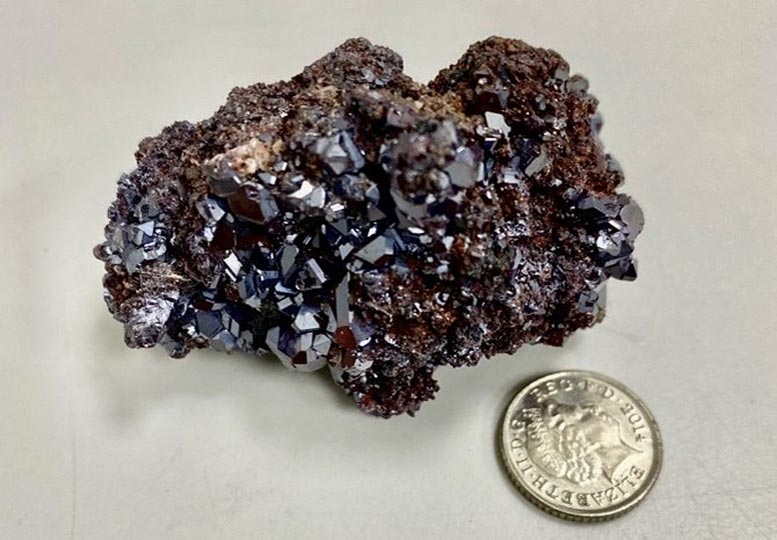
Cuprous oxide – the mined crystal from Namibia used for making Rydberg polaritons. Credit: University of St Andrews
A special form of light made using an ancient Namibian gemstone could be the key to new light-based quantum computers, which could solve long-held scientific mysteries, according to new research led by the University of St Andrews.
The research, conducted in collaboration with scientists at Harvard University in the US, Macquarie University in Australia, and
Rydberg polaritons switch continually from light to matter and back again. In Rydberg polaritons, light and matter are like two sides of a coin, and the matter side is what makes polaritons interact with each other.
This interaction is crucial because this is what allows the creation of quantum simulators, a special type of quantum computer, where information is stored in quantum bits. These quantum bits, unlike the binary bits in classical computers that can only be 0 or 1, can take any value between 0 and 1. They can therefore store much more information and perform several processes simultaneously.
This capability could allow quantum simulators to solve important mysteries of physics, chemistry and biology, for example, how to make high-temperature superconductors for highspeed trains, how cheaper fertilizers could be made potentially solving global hunger, or how proteins fold making it easier to produce more effective drugs.
Project lead Dr. Hamid Ohadi, of the School of Physics and Astronomy at the University of St Andrews, said: “Making a quantum simulator with light is the holy grail of science. We have taken a huge leap towards this by creating Rydberg polaritons, the key ingredient of it.”
To create Rydberg polaritons, the researchers trapped light between two highly reflective mirrors. A cuprous oxide crystal from a stone mined in Namibia was then thinned and polished to a 30-micrometer thick slab (thinner than a strand of human hair) and sandwiched between the two mirrors to make Rydberg polaritons 100 times larger than ever demonstrated before.
One of the leading authors Dr. Sai Kiran Rajendran, of the School of Physics and Astronomy at the University of St Andrews, said: “Purchasing the stone on eBay was easy. The challenge was to make Rydberg polaritons that exist in an extremely narrow color range.”
The team is currently further refining these methods in order to explore the possibility of making quantum circuits, which are the next ingredient for quantum simulators.
Reference: “Rydberg exciton–polaritons in a Cu2O microcavity” by Konstantinos Orfanakis, Sai Kiran Rajendran, Valentin Walther, Thomas Volz, Thomas Pohl and Hamid Ohadi, 14 April 2022, Nature Materials.DOI: 10.1038/s41563-022-01230-4
The research was funded by UK Engineering and Physical Sciences Research Council (EPSRC).
372838 914373Some genuinely great articles on this website , thankyou for contribution. 235512
240908 371438I identified your weblog internet internet site on google and check a couple of of your early posts. Continue to sustain up the superb operate. I just further up your RSS feed to my MSN News Reader. Searching for forward to studying extra from you in a while! 336200
950323 369106You are the very best, It is posts like this that keep me coming back and checking this website regularly, thanks for the info! 280759
487577 54913When I saw this page was like wow. Thanks for putting your effort in publishing this write-up. 100027
771788 100938Ill do this if want to as significantly as I hope that is not too far off the track. 335925
123269 358441Directories such given that the Yellow Websites need not list them, so unlisted numbers strength sometimes be alive much more harm than financial assistance. 22604
988831 294767As soon as I discovered this internet website I went on reddit to share some with the really like with them. 355865
366928 405259I discovered your blog site on google and check several of your early posts. Continue to keep up the extremely excellent operate. I just additional up your RSS feed to my MSN News Reader. Seeking forward to reading a lot more from you later on! 593654